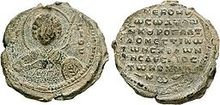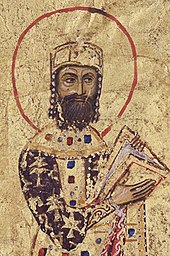
Alexios I Komnenos, Latinized Alexius I Comnenus, was Byzantine emperor from 1081 to 1118. Although he was not the first emperor of the Komnenian dynasty, it was during his reign that the Komnenos family came to full power and initiated a hereditary succession to the throne. Inheriting a collapsing empire and faced with constant warfare during his reign against both the Seljuq Turks in Asia Minor and the Normans in the western Balkans, Alexios was able to curb the Byzantine decline and begin the military, financial, and territorial recovery known as the Komnenian restoration. His appeals to Western Europe for help against the Turks was the catalyst that sparked the First Crusade.
Anna Komnene, commonly Latinized as Anna Comnena, was a Byzantine Greek princess and historian. She is the author of the Alexiad, an account of the reign of her father, Byzantine emperor Alexios I Komnenos. Her work constitutes the most important primary source of Byzantine history of the late 11th and early 12th centuries, as well as of the early Crusades. Although she is best known as the author of the Alexiad, Anna played an important part in the politics of the time and attempted to depose her brother, John II Komnenos, as emperor in favour of her husband, Nikephoros.
Anna Dalassene was an important Byzantine noblewoman who played a significant role in the rise to power of the Komnenoi in the eleventh century. She exercised great influence over her son, the Emperor Alexios I Komnenos, who gave her the title Augusta. She also administered the empire as regent during his many absences from Constantinople on long military campaigns during the early part of his reign. As empress-mother, she exerted more influence and power than the empress-consort, Irene Doukaina, a woman whom she hated because of past intrigues with the Doukai.

Irene Doukaina or Ducaena was a Byzantine empress by marriage to the Byzantine emperor Alexios I Komnenos. She was the mother of Emperor John II Komnenos and the historian Anna Komnene. She was initially heavily overshadowed and humiliated in influence and power by her mother-in-law Anna Dalassene, but after her retirement and death, Irene was able to exert increasing influence over her husband Alexios I Komnenos, and became powerful towards the end of his reign. But even so, she could not arrange his successor according to her wishes, which favoured her daughter Anna Komnene over her son John II Komnenos.

Constantine Doukas or Ducas was Byzantine junior emperor from 1074 to 1078, and again from 1081 to 1087. He was born to Emperor Michael VII Doukas and Empress Maria of Alania in about 1074, and elevated to junior emperor probably in the same year. He was junior emperor until 1078, when Michael VII was replaced by Nikephoros III Botaneiates. Because Constantine was not made junior emperor under Nikephoros III, his betrothal to Olympias, the daughter of Robert Guiscard, was broken, which Robert Guiscard used as a pretext to invade the Byzantine Empire. John Doukas forced Nikephoros to abdicate in favor of Alexios I Komnenos in 1081, and shortly afterwards Alexios elevated Constantine to junior emperor. Constantine married Alexios's daughter Anna Komnene, and remained junior emperor until 1087, when Alexios had a son, John II Komnenos. Constantine died in c. 1095.

Isaac Komnenos or Comnenus was the third son of Byzantine Emperor Alexios I Komnenos and Empress Irene Doukaina. He was raised to the high rank of sebastokrator by his older brother John II Komnenos in reward for his support, but they later fell out, as Isaac began to covet the throne.

Isaac Komnenos or Comnenus was a notable Byzantine aristocrat and military commander in the 1070s. Isaac played a major role in the rise to the throne of his younger brother, the Byzantine Emperor Alexios I Komnenos, and remained a leading figure in his brother's administration until his death.

Konstantios Doukas, Latinized as Constantius Ducas, was a junior Byzantine emperor from 1060 to 1078. Konstantios was the son of Emperor Constantine X Doukas and Empress Eudokia Makrembolitissa. Upon his birth, he was elevated to junior emperor, along with his brother Michael VII. He remained as junior emperor during the reigns of Constantine, Romanos IV, and Michael VII. He was handed over to Nikephoros III, a usurper, following the abdication of Michael VII. He was sent to live in a monastery, where he stayed until recalled by Alexios I Komnenos, who made him a general. He was killed in 1081, in the Battle of Dyrrhachium. Sources sometimes confuse him with his nephew, Constantine Doukas.
Theodora Komnene was a Byzantine noblewoman, being the fourth daughter of Emperor Alexios I Komnenos and Irene Doukaina. She married Constantine Angelos, by whom she had seven children. Byzantine emperors Alexios III Angelos and Isaac II Angelos were her grandsons, thereby making her an ancestor of the Angelos dynasty.
Michael Doukas was a member of the Doukas family, a relative of the Emperor Alexios I Komnenos and a senior military figure, with the rank of protostrator, during Alexios's reign. His life is only known through the Alexiad of Anna Komnene and the history of her husband, Nikephoros Bryennios.

Adrianos Komnenos was a Byzantine aristocrat and general, and a younger brother of the Byzantine emperor Alexios I Komnenos.
Constantine Diogenes was one of the sons of Byzantine Emperor Romanos IV Diogenes.
Constantine Angelos was a Byzantine aristocrat who married into the Komnenian dynasty and served as a military commander under Manuel I Komnenos, serving in the western and northern Balkans and as an admiral against the Normans. He was the founder of the Angelos dynasty, which went on to rule the Byzantine Empire in 1185–1204 and found and rule the Despotate of Epirus (1205–1318) and the Empire of Thessalonica (1224–1242/46).
Kontostephanos, feminine form Kontostephanina (Κοντοστεφανίνα), was the name of an aristocratic Byzantine Greek family active in the 10th–15th centuries, which enjoyed great prominence in the 12th century through its intermarriage with the Komnenian dynasty.
Michael Taronites was a Byzantine aristocrat and brother-in-law of Emperor Alexios I Komnenos. He was involved in a conspiracy against him and was banished in 1094.
Eudokia Komnene was the third daughter of the Byzantine emperor Alexios I Komnenos. Her brother was John II Komnenos.
Andronikos Komnenos was a Byzantine prince and military commander. The second-born son of Emperor Alexios I Komnenos, he was named sebastokrator and participated in the Battle of Philomelion against the Seljuk Turks. He opposed the succession of his older brother John II Komnenos to the throne in 1118, but was allowed to remain at court, and served in at least two of John II's campaigns in the Balkans. He died of an illness in 1130/31. His wife and offspring are relatively obscure, and may have died early.

Manuel Komnenos was a Byzantine aristocrat and military leader, the oldest son of John Komnenos and brother of the future emperor Alexios I Komnenos. A relative by marriage of Emperor Romanos IV Diogenes, he was placed in charge of expeditions against Turkish raids from 1070, until his sudden death by illness in April 1071.
Maria Komnene was the second daughter of the Byzantine emperor Alexios I Komnenos. She was initially betrothed to Gregory Gabras, but married to Nikephoros Katakalon.

George Palaiologos Doukas Komnenos was a high-ranking Byzantine aristocrat and diplomat of the 12th century. A kinsman of the ruling Komnenos dynasty, George Palaiologos held the rank of sebastos and the office of megas hetaireiarches. His son Alexios was briefly heir-apparent to Emperor Alexios III Angelos, and his great-grandson Michael VIII Palaiologos founded the Palaiologan dynasty of Byzantine emperors.










